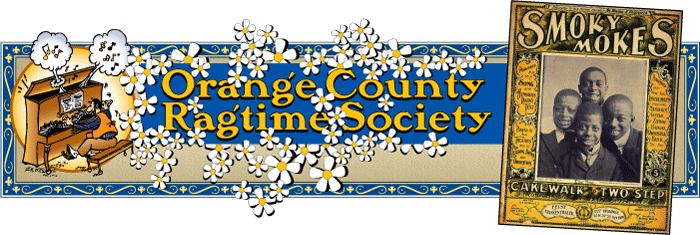March 2012 OCRS serves
up an eclectic selection of ragtime for (and on) St. Patrick’s
Day
Ragtime fans met at Steamers on a Saturday
afternoon in March, a rainy St. Patrick’s Day that saw a total
of six pianists and one banjo player. Six of the seven were on the
bill of RagFest 2012, so this performance offered audiences a wonderful
preview of that upcoming event. Variety was the order of the day,
with a generous helping of early/folk rags, classic rags, popular
rags, novelty piano, Jelly Roll Morton and contemporary ragtime compositions
as well as a small handful of ragtime-related pieces. And though the
performance was limited to three hours, the septet of musicians delivered
a total of 34 outstanding selections.
Gary Rametta emceed the meet, filling in for Eric Marchese (who had
car trouble on the way to Fullerton). Gary kicked the performance
off with three pieces he would also feature in solo sets at RagFest:
“In the Dark” (1931) from pianist, cornetist and composer
Bix Beiderbecke, L. Edgar Settle’s “X.L. Rag” (1903)
and Lamb’s masterful “Alaskan Rag,” his performance
set the tone for the afternoon, providing a compressed look at three
divergent styles of piano composition – jazz, folk ragtime and
classic ragtime. As it was composed by Lamb in 1959 to commemorate
Alaska gaining statehood, “Alaskan Rag,” published in
1966, also qualifies as a contemporary rag.
Bill Mitchell delivered Scott’s “Great Scott Rag”
and, from 1912, “Bag of Rags” by W.R. McKanlass. John
Reed-Torres offered an all-classic-ragtime set with Joplin’s
“Peacherine,” Scott’s “Pegasus” and
Joplin’s “Sugar Cane.”
Continuing in the classic rag vein, Ryan Wishner delivered two of
the best of that sub-genre: Lamb’s “Top Liner,”
often considered his greatest work, and Scott’s “Frog
Legs,” the 1906 rag that put the young Missourian on the map
as a ragtime composer of note. Scott’s score takes the second
half of the rag from the tonic of D-flat major to the dominant key,
A-flat major. Ryan, however, performs the piece by moving into the
subdominant key of G-flat major for the last two themes – a
key change more typical of ragtime but also a far more difficult and
challenging one to perform. Ryan capped his outstanding set with Kerry
Mills’ 1907 Indian intermezzo “Red Wing.”
Shirley Case offered two tunes from her outstanding CD – Imogene
Giles’ “Red Peppers” and Blake’s “Eubie’s
Classical Rag” – with Lamb’s “Bird-Brain Rag”
sandwiched between them.
Vincent Johnson delivered an all-Novelty piano set of Confrey’s
“Kitten on the Keys,” Rube Bloom’s “Spring
Fever” and Roy Bargy’s “Omeomy.” While “Kitten”
has become something of Vincent’s signature tune, it’s
nice to hear him do especially difficult selections from the pens
of people like Bloom and Bargy.
Bill Mitchell then returned to the piano and invited Jimmy Green to
join him on banjo for three selections. The first two, “Milenberg
Joys” and “Someday Sweetheart,” are by Jelly Roll
Morton and the third, “Grace and Beauty,” by Scott. And
though the latter is, like “Great Scott,” from 1909, it’s
considered Scott’s masterpiece. It’s also considered among
the three greatest rags ever written (along with “Top Liner”
and “Maple Leaf Rag.”)
John Reed-Torres offered Aufderheide’s vintage “The Thriller”
and Joplin’s masterful “Gladiolus.”
Ryan opened his encore set with “Car-Barlick Acid,” a
rollicking folk rag copyrighted in 1901 by Oskaloosa, Iowa pharmacist
Clarence Wiley. He sold the piece to a small publisher in 1903, and
after it was picked up by Remick in 1907, this wonderful early rag
began to receive national exposure. Ryan’s second encore: a
piano arrangement of the 1922 song “Titina” by Frenchman
Léo Daniderff. The piece first appeared with English lyrics
in the U.S. stage revue “Puzzles of 1925.” Ryan’s
performance is based on the 1920s Ampico piano roll that Zez Confrey
cut, including the trio section he created especially for the roll
arrangement.
Shirley encored with two outstanding rags by Irene Giblin –
“Sleepy Lou” (1906) and the earlier “Chicken Chowder”
(1905), a number Shirley and Nan Bostick had long ago worked up into
an exciting two-piano duet.
Vincent had two more great novelties up his sleeve: Arthur Schutt’s
“Rambling in Rhythm” and Ralph Rainger’s “Pianogram”
(1929).
Gary encored with two contemporary rags: DTR’s moving “Through
the Bottomlands” and Trebor Tichenor’s “The Show-Me
Rag – A Ragtime Defiance” (1976). While vintage ragtime
is often extraordinary, it’s nice to see at least one OCRS regular
making a concerted effort to mine, memorize and perform some of the
greatest ragtime pieces composed in recent decades.
For St. Patrick’s Day, Andrew Barrett delivered three appropriate
pieces, all of which are now in their 100th year. He sang and accompanied
himself on “When Irish Eyes are Smiling” (1912). With
words by Chauncey Olcott and George Graff, Jr., and music by Ernest
Ball, the song was written for Olcott’s production of the stage
show “The Isle O’ Dreams.” Andrew’s next “Irish”
selection was “Kathleen Kildare.” Andrew again both sang
and played this 1912 song (music by Emmanuel Klein) that was patterned
after the style of old Irish ballads. He offered a piano arrangement
of yet another 1912 standard, “It’s a Long Way to Tipperary,”
then closed his set with “Ragtime Amanda,” a beautiful
original of his from 2008-’09.
To wind up the abbreviated musicale, Jimmy and Bill again took the
stage, this time with the rousing “Grandpa’s Spells,”
(Morton), “Ballin’ the Jack” (Burris and Smith)
and the granddaddy of all rags, “Maple Leaf.” It was a
wonderful afternoon producing a total of 34 selections and not only
providing tremendous variety, but also creating a wonderful preview
of RagFest 2012.

